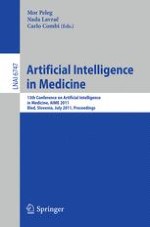This book constitutes the refereed proceedings of the 13th Conference on Artificial Intelligence in Medicine, AIME 2011, held in Bled, Slovenia, in July 2011.
The 42 revised full and short papers presented together with 2 invited talks were carefully reviewed and selected from 113 submissions. The papers are organized in topical sections on knowledge-based systems; data mining; special session on AI applications; probabilistic modeling and reasoning; terminologies and ontologies; temporal reasoning and temporal data mining; therapy planning, scheduling and guideline-based care; and natural language processing.
